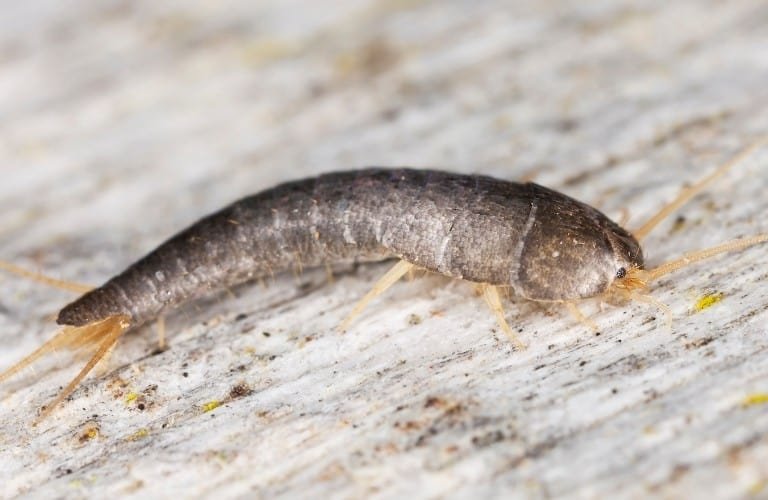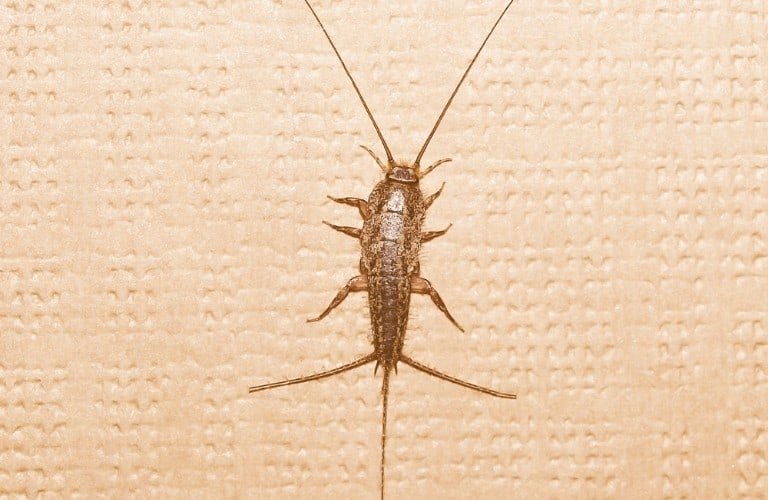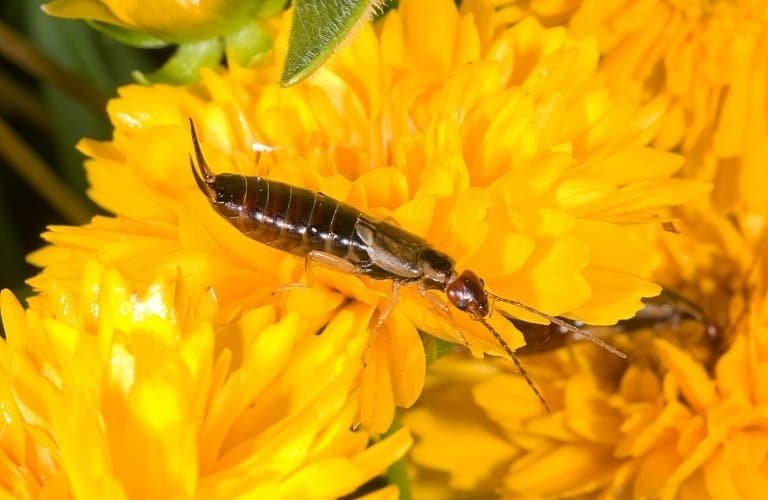Once earwigs have invaded your yard and home, you need to act fast to find products to eliminate them immediately and prevent their return in the future.
By understanding how pesticides work to kill earwigs, you can choose the best product for your specific situation and lifestyle.
What are the best pesticides for earwigs? For earwig elimination, the best pesticides are generally from the pyrethroid group of incesticides. Products containing deltamethrin, beta-cyfluthrin, cypermethrin, bifenthrin, or esfenvalerate, are recommended, though natural options like neem can work as well.
In the following, we’ll walk you through the many choices of natural, and synthetic pesticides to put you back in control.
Best Practices for Preventing an Infestation
Before choosing a pesticide, it’s important to know exactly what type of insect you are attempting to eliminate.
The term “broad range” comes up a lot when discussing pesticides.
Broad-range or broad-spectrum pesticides are created to repel and kill a large number of different insects or other living organisms.
For instance, if there are unknown pests or an undetermined number of different pests causing damage or infesting an area, broad-range insecticides work well to manage them.
Earwigs are easily identified by their pincers, but there are other insects that closely resemble them and may be mistaken for them.
Earwigs
The common earwig is between ½ inch and 1 inch long at maturity. They range in color from a reddish to dark brown.
The biggest distinguishing feature of an earwig is the presence of pincers on their back end. They have antennae and wings, but most cannot fly.
Are they dangerous and do they bite? We answer that here.
Silverfish
Silverfish are similar in appearance to earwigs in size, flattened body shape, and the presence of antennae.
They do not have pincers, but they do have three long prongs or “bristles” on their back end.
The biggest difference between earwigs and silverfish is their color. Earwigs are dark brown while silverfish are silvery gray, almost metallic in color.
(We cover facts about silverfish as well as prevention and treatment methods here.)
Firebrat
Firebrats resemble both earwigs and silverfish due to their antennae, flat bodies, and the similar three-pronged tail like the silverfish.
They are smaller though, growing to only ½ inch at maturity.
Firebrats can also be identified by their color. Their coloring falls somewhere between brown and gray with dark spots on their backs.
Basic Guidelines
The best form of pest control is prevention.
Knowing what to do to prevent attracting earwigs to your home and yard will reduce the need for long-term dependence on pesticides.
If you’re a bit hesitant to use pesticides, follow the prevention methods given below carefully, and check out our article, “How to Get Rid of Earwigs” for alternative approaches.
Outdoor Prevention Measures
Prevent earwigs from invading your yard and garden by eliminating the places they like to hide and sealing access points.
- Remove things like decomposing leaf piles, dead grass, and wood piles.
- Keep the lawn mowed and weeds, bushes and trees trimmed.
- Keep gutters and downspouts clean and clear.
- Fix leaky hose bibs.
- Replace mulch with pea gravel or crushed stone.
- Seal cracks or holes in the foundation.
- Replace torn screens and loose weatherstripping around doors.
Indoor Prevention Measures
Once inside, earwigs will head toward sources of food and moisture. In this article you’ll learn what earwigs will happily munch on when inside your home.
Indoor prevention measures include:
- Repair any leaking pipes or faucets.
- Wipe kitchen counters clean with a disinfectant.
- Remove food and crumbs promptly from countertops.
- Clean crumbs from the toaster regularly.
- Clean stove often and thoroughly to remove grease.
- Vacuum frequently.
In dark, damp basements, run a dehumidifier, and store clothes, bedding, and old books in plastic storage containers, like these from IRIS USA.
Maintaining a clean home is a huge earwig deterrent, so this is not the time for a half-hearted effort.
What to Look for in Pesticides
Since there are an incredible number of pesticides available for indoor and outdoor use, it can be overwhelming to pick one.
By knowing what to look for as a starting point, it makes paring down the choices much easier.
When choosing a pesticide to kill earwigs, it is extremely important to consider factors other than just eliminating these pests.
- Consider how the product will affect everyone in the home, especially those with children and pets.
- Be informed about product toxicity levels, labeling, and safety ratings.
- Also consider where the primary source of the infestation seems to be coming from (hint: it’s always outdoors).
- Consider how much time it will take for pesticide application, where to apply safely, and how long it will last before needing reapplication.
Other considerations include price, if the product permanently stains carpet or furniture, and what you feel comfortable using in and around your home.
Don’t feel like pesticides are your only option. We share alternative elimination techniques in our article, “What Kills Earwigs?”
Types of Pesticides
The broad term “pesticides” can be broken down by subsets to more specifically describe the chemical groups used to control and/or kill anything from fungus to insects to weeds and more.
After “Insecticides,” it breaks down even further into natural, plant-based pesticides, like pyrethrum, and synthetic versions.
| SYNTHETIC | |||
| Organo-chlorines | Organo-phosphates | Carbamates | Pyrethroids |
| DDT
BHC |
Malathion
Dichlorvos Fenitrothion Fenthion Temephos |
Carbaryl
Bendiocarb Propoxur |
Bifenthrin
Cyfluthrin Cypermethrin Deltamethrin Esfenvalerate Lambda-cyhalothrin Permethrin |
Some of the most toxic insecticides are active ingredients in the organochlorines and organophosphates groups.
These types of chemicals contain ingredients that should be avoided for use around children or pets.
The five most common chemical groups of insecticides (with examples) are:
| Group | Example |
| Botanicals | Pyrethrins (of chrysanthemums) |
| Carbonates | Carbaryl |
| Chlorinated Hydrocarbons | DDT |
| Minerals | Borax |
| Organic phosphates | Malathion |
Effectiveness
One determining factor in choosing a pesticide for earwigs is effectiveness.
Research and understand how the product works, how long it takes to kill the pest, and the manner of extermination.
Extermination methods typically attack the central nervous system or cause severe dehydration of the pest.
Safe for Use Around People and Pets
Another important deciding factor is how safe the product is, especially when using indoors or around people and pets.
Pay close attention to toxicity levels and safety ratings. Most insecticides are safe for kids and pets once dry, but some are not.
It’s imperative to read the warning labels to know for sure.
Ease of Use
Consider how the product is packaged for use.
Does it come in a ready-to-use spray, in granules, or require some form of measuring and mixing?
The easier the product is to use, the more motivated you will be to keep up with required treatments.
Another consideration is how to dispose of empty pesticide containers. Check recycling or trash guidelines in your area for specifics.
Best Indoor Pesticides for Earwigs
After running through the checklist of things you’re looking for in a pesticide, consider these suggestions to jumpstart your selection process.
In most cases, product recommendations are labeled for use both indoors and outdoors.
It is always important to read the safety warnings, precautions, and directions for application before using any pesticide.
Suspend Polyzone
Suspend is a broad-range insecticide with the active ingredient deltamethrin and a special controlled-release formulation.
This synthetic, botanical chemical works by attacking the central nervous system functions of earwigs after contact or ingestion.
This product kills over 50 insects including ants, bed bugs, centipedes, and silverfish within a few minutes.
It’s safe for use indoors, outdoors, and as a perimeter pesticide.
Suspend Polyzone lasts up to three months by leaving a clear surface residual on treated surfaces.
Pros:
- Easy to measure and mix.
- Low odor.
- Stain-free.
- Pet safe when dry.
Cons:
- Leftover mixture becomes inactive after 24 hours.
- Can be lethal to aquatic pets.
- Residual ineffective when exposed to water.
Tempo SC Ultra
No products found.
No products found.
This is a broad-spectrum insecticide powered by the active pyrethroid ingredient beta-cyfluthrin.
This insecticide kills pests by stomach poisoning and an attack on the nervous system, resulting in paralysis, starvation, and death.
It is labeled for outdoor applications and indoor areas such as cracks and crevices – ideal earwig hiding spots.
Tempo SC Ultra kills 100+ insects, such as flies, moths, and wasps. Indoor treatment lasts for up to 30 days, while outdoor treatment lasts up to 90 days.
Pros:
- Very little to no residual residue.
- Affordably priced.
- Liquid suspension uses less formula to cover more area.
- Low toxicity for people.
Cons:
- Cannot use on edible plants.
- Lethal to aquatic pets.
- Kills bees.
BioAdvanced Home Pest Plus Germ Killer
This product acts as an insecticide and eliminates up of 99.9% of lingering insect germs.
BioAdvanced is a ready-to-use product with active ingredients beta-cyfluthrin and sodium o-phenyl phenate.
These ingredients kill earwigs by attacking the central nervous system after ingestion and work instantly.
Protection lasts for 6-12 months.
Pros:
- Easy to apply.
- Germ killer.
- Can be used as an outdoor perimeter treatment.
Cons:
- Strong odor.
- Indoor crack/crevice use only.
- May need to re-apply after rainfall.
Martin’s Viper Insecticide Concentrate
This product kills earwigs with cypermethrin, which works by paralyzing with death following quickly due to the inability to move or eat.
A broad-spectrum concentrate, it works on many other insects, such as flies, fleas, centipedes, and wasps.
It leaves a protective barrier which lasts up to three months.
Pros:
- Broad-range product.
- Easy to mix.
- People/pet friendly when dry.
Cons:
- Strong odor: indoor ventilation is required.
- Precise measurements required to mix correct amounts of concentrate.
Syngenta Demand CS
This product features micro-encapsulated technology.
This technology works at application when thousands of encapsulated micro particles, containing the active ingredient lambda-cyhalothrin, release and bind to the application surface.
The micro particles attach to earwigs and other insects that take the insecticide back to the nest and consequently wipe out an entire colony.
Lambda-cyhalothrin works by damaging the central nervous system. Effective on 30+ insects, Demand CS is approved for both indoor and outdoor use.
Pros:
- Safe for indoor/outdoor use including lawns and ornamental trees/shrubs.
- Little to no odor.
- Stain free.
Cons:
- Does not kill instantly; a longer-term solution.
- May need reapplication after rain.
Best Outdoor Pesticides for Earwigs
It is recommended that pesticides be used primarily outdoors where colonies of earwigs congregate.
By eliminating the earwigs outside, the likelihood of them coming indoors is reduced.
Outdoor pesticide application has its own set of concerns, such as harming plants, gardens, trees, shrubs, and natural wildlife, like bees and birds.
Talstar PL
This product is a professional-strength insecticide with the active ingredient bifenthrin.
Bifenthrin works by paralyzing the insect, which dies quickly.
Talstar kills and manages earwigs and over 70 other insects and pests, including ants, mosquitoes, spiders, termites, and fleas.
It can also be used to treat insects hidden in the lawn.
Talstar has a long residual (how long treatment protects before reapplication) of over three months after application.
Pros:
- Safe for trees and shrubs.
- Odorless.
- Stain-free.
- Does not break down easily in rain.
- Pet friendly.
Cons:
- Cannot be used in vegetable/food gardens.
- Fairly expensive.
Bifen L/P
Bifen L/P is both an insecticide and termiticide effectively killing earwigs and over 75 other pests.
The active ingredient is bifenthrin, a botanical-based, synthetic insecticide derived from chrysanthemums.
It works to kill insects by paralyzing and starvation, typically anywhere from minutes to hours after ingestion.
These insecticidal granules provide long-lasting residual protection for up to three months.
Pros:
- Low-cost alternative to Talstar.
- Easy to use.
- Odorless.
- Won’t harm birds, pets, or other mammals.
Cons:
- Not recommended for use near fruits or vegetables.
- Toxic to birds, honeybees, and earthworms.
Paragon Conquer
This insecticide is powered by esfenvalerate, which works to kill earwigs by attacking the nervous system, leading to paralysis and starvation.
It’s available in a variety of application methods for excellent broad-spectrum, general insecticide usage.
In addition to earwigs, this product eliminates carpenter ants and deer ticks and is approved for both indoor and outdoor use.
Pros:
- Results with even low-concentration levels.
- Can be mixed with oil or water.
- Long-lasting residual control.
Cons:
- Not to be used near food or food prep areas.
Onslaught Insecticide
Onslaught features micro-encapsulated, slow-release technology that provides excellent long-term residual control of earwigs and over 200 other pests and flying insects.
It is powerful enough to eliminate bed bugs, fleas, and cockroaches.
It’s approved for both outdoor and indoor use, including commercial food and food-prep environments.
There is an approximate 30-day residual for indoor applications.
Pros:
- Easy to use.
- Odorless.
Cons:
- Long-term, not immediate, results.
Wondercide Natural Outdoor Pest Control Concentrate
Instead of using synthetic insecticides, Wondercide works just as well by using all-natural ingredients.
The natural active ingredient in this product is high-quality, plant-based cedarwood oil.
It works to kill effectively in all stages of the insect life cycle from egg to adult by suffocating the insect.
It both eliminates and repels earwigs, fleas, ticks, and mosquitoes while keeping birds, bees, and butterflies safe.
Wondercide can be sprayed anywhere in the yard and directly on plants and in gardens.
For high insect activity, treat the yard and garden for two weeks, applying product once per week.
For prevention and maintenance, apply Wondercide every 30-45 days.
Pros:
- 100% kid/pet friendly before and after drying.
- Will not harm exterior finishes like brick or siding.
- Pleasant smell.
Cons:
- More frequent applications.
- May need reapplication after heavy rains.
Neem Oil
Neem oil is a popular and effective organic insecticide derived from the India native neem tree.
The Environmental Protection Agency reported that neem oil has “no unreasonable adverse effects,” making it a safe and environmentally friendly alternative for outdoor use.
The active ingredient in neem oil is azadirachtin, which works by disrupting regulatory hormones in the pests and smothering them.
Neem oil kills over 200 insects, including earwigs, aphids, mites, and mealybugs.
Pros:
- All natural.
- Will also prevent and treat certain plant bacterial and/or fungal infestations.
Cons:
- Reapplication may be necessary every two to four weeks.
Summary
Now that you have the information about natural, and synthetic pesticides and how effective each will be in removing earwigs from your home and yard, you’re in a much better position to make an informed decision.
You’ll definitely have an edge when it comes to comparison shopping.
Our top recommendations are based on safety, effectiveness, ease of use, and ultimately, results.
Choosing the best pesticide for earwigs doesn’t have to be a daunting task.
By considering the active ingredients, how they work as insecticides/repellents, plus the pros and cons of featured insecticides, it becomes much easier to choose a product that is both safe and effective for you, your family, and pets.
Still not too sure that pesticides are the way to go? That’s okay. You have other options that will help you win the fight against earwigs.
Don’t miss out on other prevention tips and elimination methods. You can find them all right here.

















